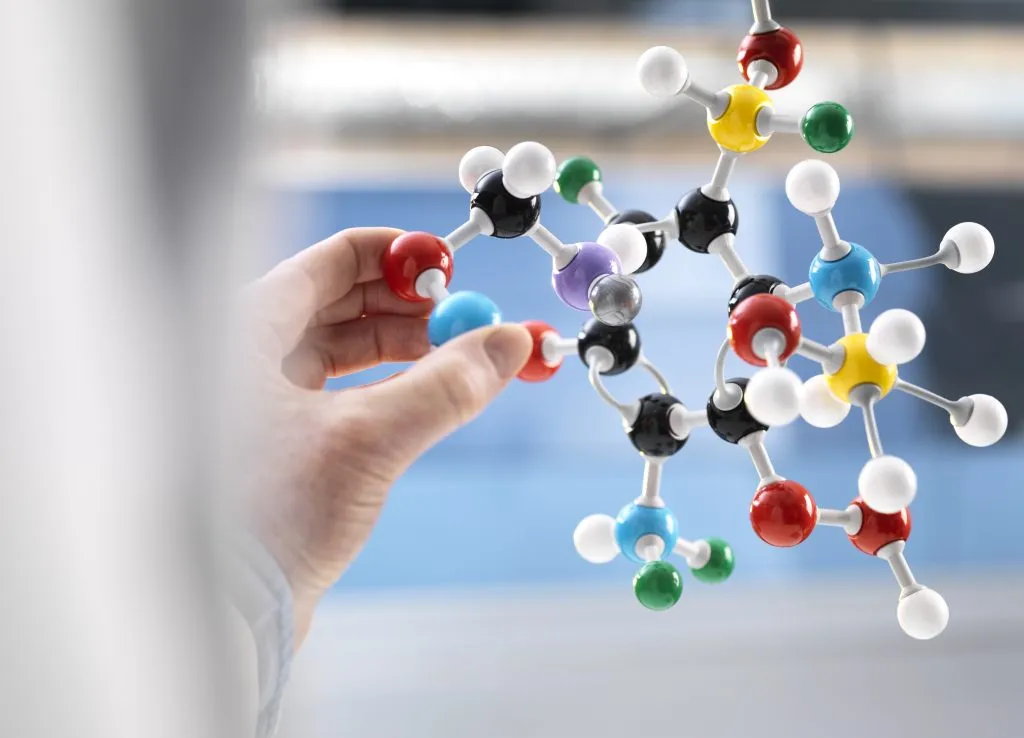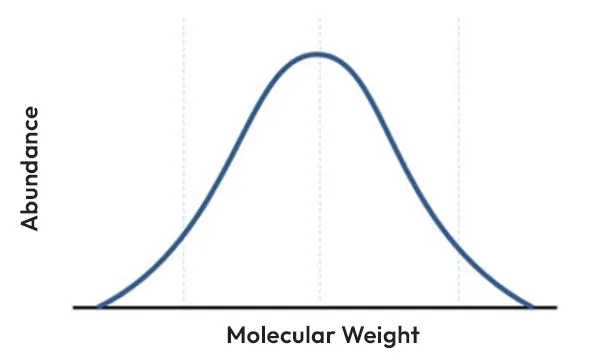Determination of Molecular Weight Distribution (GPC/SEC)

Chromatography was developed in the early 20th century as a method of separating a mixture into its individual components. Chromatographic systems consist of a column filled with two phases—a mobile phase and a stationary phase—which can be solid, liquid or gas. The stationary phase stays in place and does not move during the separation process, while the mobile phase moves through this stationary phase.
Separation occurs due to the interaction of the different components of the mixtures with both phases. Molecules with more affinity towards the stationary phase are retained longer in the column, while molecules with greater affinity towards the mobile phase move through it quicker.

Sistema de separación por cromatografía en columna.
GPC/SEC Technique
The GPC/SEC technique is a type of liquid chromatography that employs a porous solid stationary phase whose separation mechanism is based on the size of the molecules in solution rather than other chemical interactions, hence the name size exclusion chromatography (SEC). The mobile phase can flow through these solid particles and their pores. Traditionally, the porous medium was made of a gel and thus the name gel permeation chromatography (GPC) was also coined, but both terms refer to the same analytical technique.
Many of the properties of polymeric and plastic materials used in industry and daily consumption, such as mechanical strength and elasticity, come from the coiling of polymer chains. In general, the longer the chains, the more coiled up they are and the harder and more resistant the material is. Material properties therefore vary depending on chain size, even when the chemical composition is the same. Additionally, all synthetic polymers contain a distribution of polymer chain lengths; in fact, it is impossible to make polymers whose chains all have the same length. The GPC/SEC technique makes it possible to separate chains of different lengths and measure their relative abundance. It is important to note that slight differences in chain length can cause significant differences in material properties.
Molecular Weight Distribution and Relative Abundance

GPC/SEC has two main uses: to characterize polymers and separate mixtures into discrete fractions such as polymer, oligomer, monomer and non-polymeric additives. To determine the molecular weight distribution of a polymer sample, a calibration with a standard polymer of known molecular weight is necessary. There are two methodologies depending on the detectors used for the analysis: conventional GPC/SEC and multi-detector GPC/SEC.
Conventional GPC/SEC Technique
In conventional GPC/SEC, a single detector is used, which usually measures either UV-Vis absorbance or differential refractive index. During the analysis, the GPC/SEC column separates the polymer molecules based on their size in solution, and the detector determines the amount of eluted material based on the retention time in the column. This retention time is converted to molecular weight using a calibration curve also obtained with polymer standards of different known molecular weights to obtain a graph of retention times and molecular weights. In the calculations, the sample peak of the material eluted from the column is divided into “slices” and the retention time of each slice is used to determine its molecular weight. The area or height of the slice is used to determine its percentage relative to the total sample, i.e. the relative abundance. The percentage and molecular weight data are then used to calculate the molecular weight distribution.
Although the conventional GPC/SEC technique is widely used, it has some limitations. If the standard used to create the calibration curve has a chemical structure similar to the sample of interest, the calculation performed with the prepared calibration curve is more accurate. However, if the chemical nature of both polymers is different, the results obtained may be merely comparative. This is because GPC columns separate based on size in solution, not molecular weight. When performing conventional GPC/SEC calculations, it is assumed that a certain size in solution corresponds to a certain molecular weight. However, different types of polymers with different chemical natures can form coiled spheres of different sizes of the same molecular weight.

Comparison of Sizes of Two Polymers of the Same Molecular Weight in the Same Solvent
This technique also provides rather limited information because, although the column separates polymer molecules based on their size in solution, the detector only determines the concentration of the molecules eluting from the column. Their size in solution, though crucial for the separation mechanism, is not measured in the analysis. Therefore, comparatively speaking, conventional GPC/SEC is not an information-rich technique.
Multi-Detector GPC/SEC Technique
For these reasons, the multi-detector GPC/SEC technique has emerged. This technique combines a concentration detector like those used in conventional methodology with other detectors such as a viscometer and light scattering detector. This makes it possible to calculate molecular weights that do not depend on the chemistry of the calibration standards and determine other properties of the polymers.
The most common multi-detector GPC technique combines a concentration detector with a viscometer. The viscometer measures the viscosity of material solutions, which, along with the concentration information of the different components separated in the chromatographic column, provides information about the behaviour of polymer molecules in solution. Before starting analyses with this technique, the concentration detector and viscometer are calibrated with a standard of known concentration, intrinsic viscosity and molecular weight. During this process, any time delay between the two detectors is also determined.
Measuring intrinsic viscosity makes it possible to determine molecular weights through universal calibration. This method enables calculation of molecular weights regardless of the chemistry of the standards used for calibration. This type of calibration is based on the fact that intrinsic viscosity and molecular weight are related to the size of the molecules in solution through hydrodynamic volume. Therefore, if a calibration curve is generated for a set of standards with known molecular weight and intrinsic viscosity versus retention time, this is equivalent to the relationship of size in solution to retention time. Given that the column separates molecules based on this size in solution, the same calibration curve is generated regardless of the standards used.
Static Light Scattering
Another commonly used detection tool in GPC/SEC is the static light scattering detector. This method involves irradiating the material eluted from the column with a laser and measuring the intensity of the scattered light. This technique is more complex than viscometry and has some practical limitations. However, combining it with a concentration detector can reveal a great deal of information about the polymer molecules in solution. This detector measures a property called the Rayleigh ratio, which is directly proportional to the molecular weight and concentration of the molecule in solution. Therefore, to calibrate the system, a standard of known concentration and molecular weight is required.
One of the main limitations of this technique arises when the molecules have a very small size in solution. In this case, the molecules act as a single point scattering light symmetrically in all directions, resulting in weak signals in the detector, which can make measurement using this detector difficult.
Finally, it is also possible to use both detectors with the concentration detector. Calibration is thus carried out in the same manner as with the method that uses only the light scattering detector but includes the viscosity information of the calibration standard. Information on both the molecular weight and intrinsic viscosity of the polymer molecules in the samples is thus obtained.
At AIMPLAS, we have the necessary equipment to support companies in the plastics industry using the GPC/SEC technique.
Examples of GPC/SEC Application
Some examples where this technique has been successfully applied include:
- Comparative analysis in a synthesis process: comparing the evolution of the molecular weight of a polymer throughout the synthesis reaction by measuring extracts at different times.
- Comparative analysis of the level of chemical recycling: comparing the molecular weight obtained before and after the product undergoes one or more chemical recycling processes.
- Material characterization: determining the molecular weight of a polymer using universal or triple detection calibration.
- Defect evaluation: comparing a product with a functional problem with a similar product that does not have the problem or evaluating the molecular weight using absolute or triple detection calibration to assess if it could be the cause of the problem observed.